Published on
Pet him, he’s working: a day sniffing around Northeastern with Sarge
The 2-year-old black Lab with a powerful nose is always ready for a snuggle or a tennis ball fetch session. But the community resource dog’s training goes even deeper.
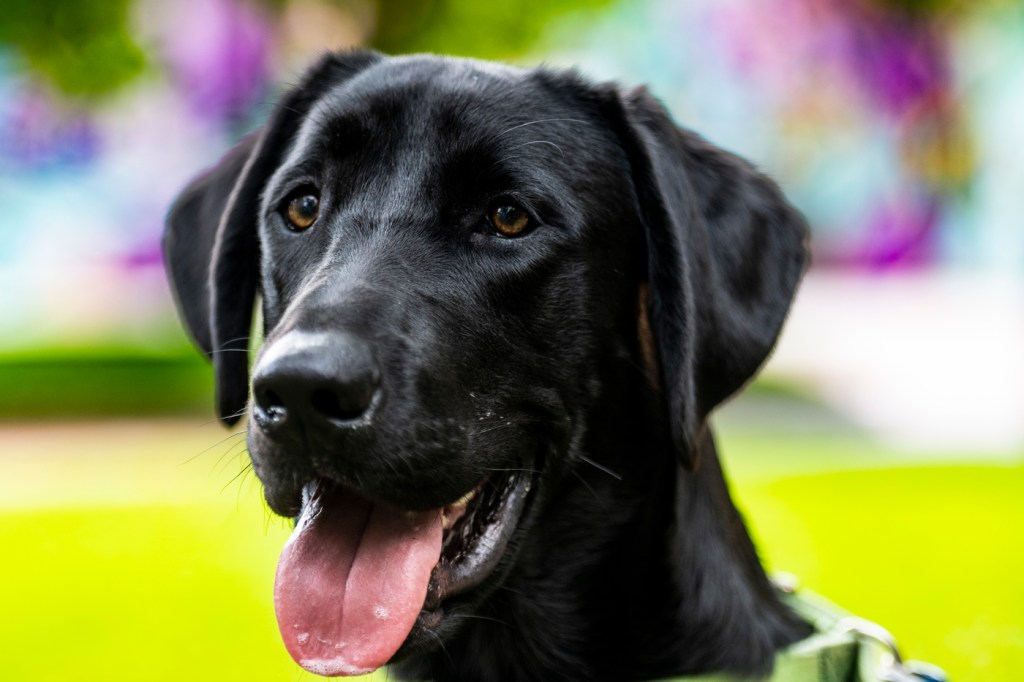
Does Sarge, the Northeastern community resource dog, ever feel overshadowed by his K-9 colleague and best friend Cooper? Like the Ken to his Barbie; the Luigi to his Mario? Cooper arrived first, in 2021, to much fanfare — the golden retriever has a series of trading cards, a robust social media presence, and a network of dozens of other golden retrievers who descend onto the Boston campus for his birthday party each year. Northeastern held a contest to pick his name.
Sarge came with the name Sarge. A group of New York police officers won his naming rights at a charity auction. “They were all sergeants,” shrugs Northeastern University Police Department Officer Sgt. Joe Corbett, his handler. The 2-year-old black American Labrador Retriever arrived on campus last year as a definitive second banana, brought on in large part to help handle the flood of requests for Cooper’s services.
But no, Sarge doesn’t seem to mind. He’s a dog, for one. And he has all the celebrity (animal) magnetism he needs on his own; it’s in full effect during Fall Fest, the day before classes start in early September. It’s a sweltering morning, even more so when you’re covered in sleek black fur. But Sarge has plenty of energy for the hordes milling about Snell Quad. He and Corbett stand in front of an NUPD table, where officers are registering students’ bikes, computers and other valuables.
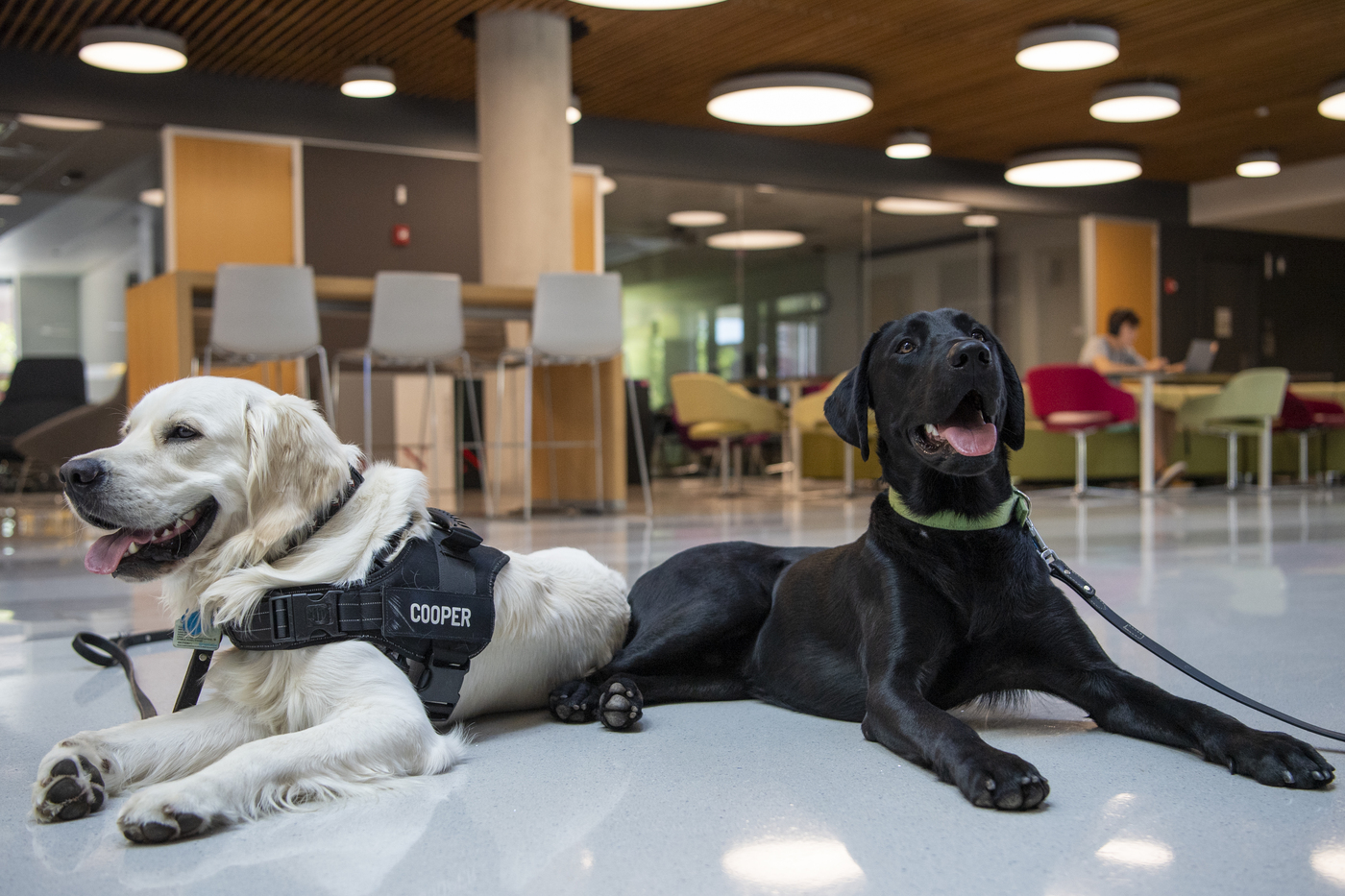
“You’re not usually allowed to greet K-9 dogs!” says Sean Balbale, an incoming freshman who bounds up to give him a chin scratch. Balbale already knows Sarge by name, which the dog responds to by thumping his tail, swooping his long black nose upward and fixing his bright, amber eyes on the speaker.
“I’m a huge dog fan,” Balbale gushes. He has a standard poodle and a Goldendoodle at his parents’ house, and his girlfriend has two black labs. Many of the students who come up to Sarge and Corbett have similar stories. Many are away from their dogs for the first time ever, and Sarge offers a comforting bit of home as they face the often-daunting first week of college.
Later on, Jessica Tiblin, a staffer for Northeastern’s Explore Program for undeclared freshmen, approaches with a large tour group of new students. They swarm Sarge, his belly up in appreciation. He rolls over a chalk-written message on the pavement and comes up with a dusty zebra pattern on one haunch. Corbett offers to take a photo; it takes longer to get the students arranged than the dog, who, off leash, strikes a perfect pose in the middle. “He makes my day every time,” Tiblin smiles.
Though, like Cooper, Sarge spends most of the time at Northeastern on this sort of community engagement work, he’s a very different dog — with different origins, skills and temperament. Sarge barks; Cooper doesn’t. Sarge will chase a tennis ball until he drops; Cooper couldn’t care less.
“Sarge is very much a police dog,” Corbett says, “and I’m very much a police officer.” Through his community engagement work at Northeastern, though, his canine partner has changed Corbett’s outlook on what that means.

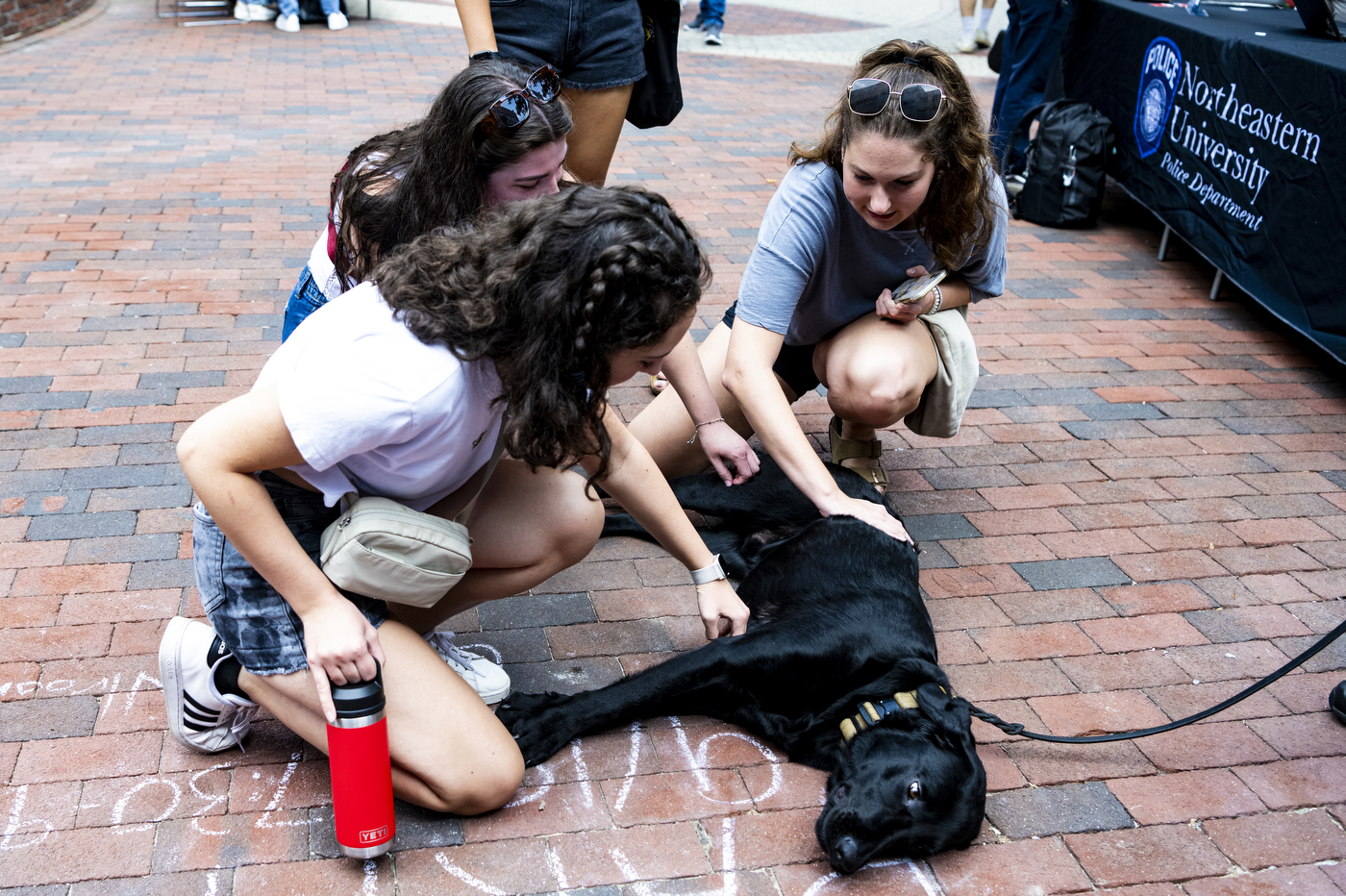
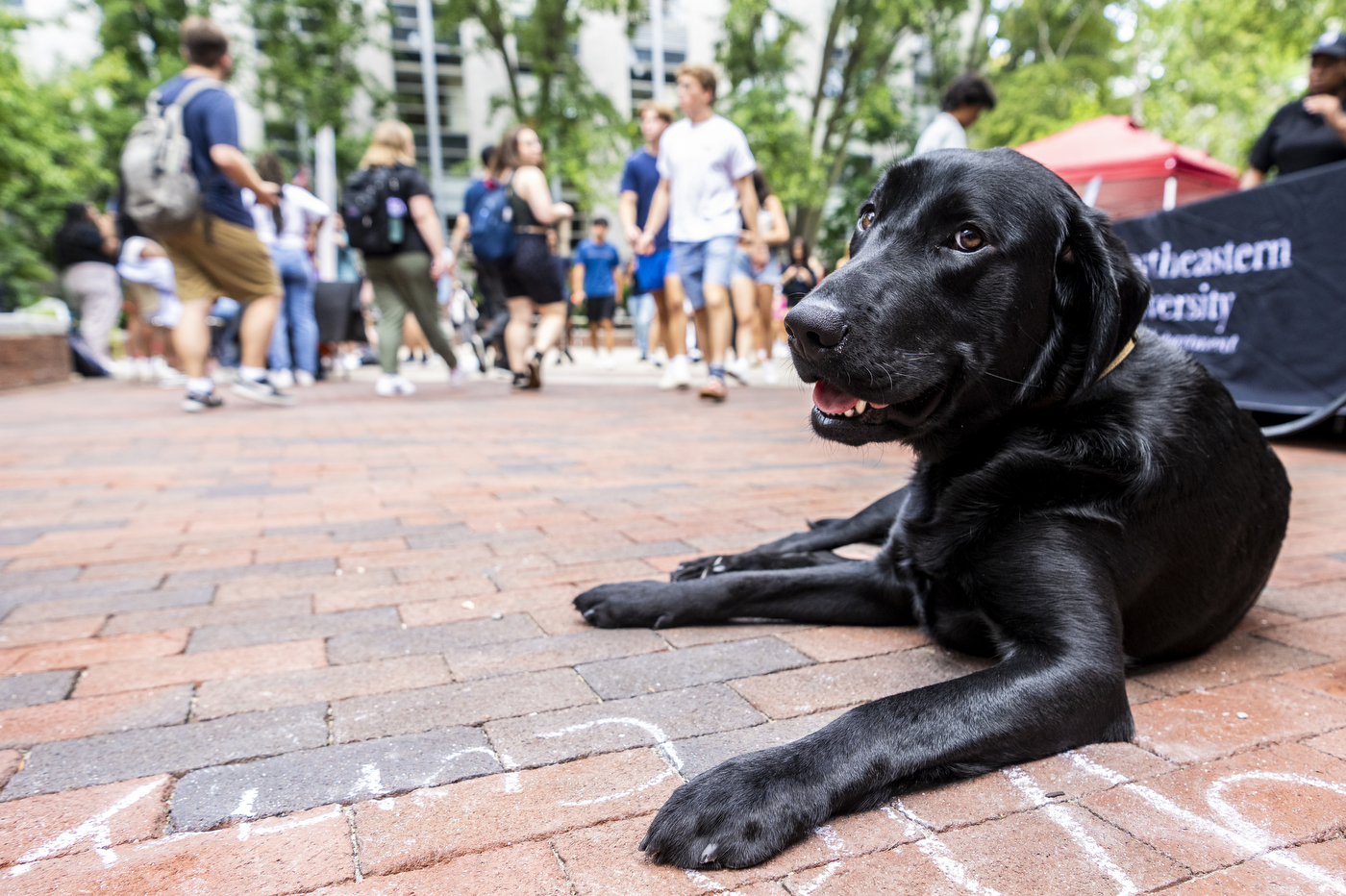
“I’ve talked to more people in the past year than I have in my entire 20-year career,” he says. “And I see the value in that. People are happy to see you, and we’re able to tell them more about what we do here.”
Puppy behind bars
Sarge and Cooper took radically different paths to Northeastern. Cooper spent his puppyhood in bucolic Walpole, Massachusetts, surrounded by other dogs and a rotating bevy of handlers. Sarge spent his in the New York prison system. He’s a graduate of Puppies Behind Bars, a program that matches would-be service dogs with inmates who raise and train them for a variety of jobs. At 8 weeks old he was sent to live with an inmate at Downstate Correctional Facility, maximum security prison in Fishkill, NY that closed in 2022.
Sarge’s inmate handlers chronicled his progress in a handwritten journal, which Corbett still keeps in his office. “I just got my wonderful, beautiful black puppy and he is mighty bossy,” the first entry reads. Training involved basic commands and getting the full run of the facility, interacting with counselors, teachers, nurses and correctional officers.
Sarge socialized well and was cooperative from the start — unless it was time to get into a car. “We had to pick him up each time and put him in,” one entry reads.
Volunteers took him on frequent and varied trips out of the facility, including to busy Manhattan and one participant’s crochet group. “The ladies absolutely loved him!” the accompanying journal entry reads. “We stayed for about an hr [sic] and a half. I brought a towel for him to [lie] on and some chewy toys and he was very content.”
Originally, Sarge was slated to be a service dog in the Cooper mold, primarily occupied with emotional support and personal help. “But some dogs are just not suited for that work,” Corbett says. “You want somebody who’s kind of chill, doesn’t bark. He barks. He runs around. He’s always trying to do something.”
The first adjective Under the American Kennel Club entry for Labrador Retrievers is “active.” Sarge fit the bill, proving suited to a career that would keep him moving and busy. Puppies Behind Bars soon placed him in their explosive-detection track. While he spends “80% to 85%” of his time at Northeastern doing community work, according to Corbett, he has a second gig as an explosives detection K-9 for the Massachusetts State Police. He’s worked security at events including the Boston Marathon, the Fourth of July celebration on the Charles River Esplanade and concerts at Gillette Stadium.
Always working
Sarge came to Northeastern a few months after his first birthday, and he lives with Corbett, his wife and three kids in Rockland, on Boston’s South Shore. For the most part, his home life is calm and restful — he has a favorite spot on the couch, and he’ll go in his crate on command. When he’s not relaxing and making appearances around campus, though, it’s all about training. He eats all of his food, a special Royal Canin formula for Labradors, as rewards during work sessions. He gets no extra treats apart from what he can sneak on the sly — once, while the kids were watching him, he got into the trash and helped himself to an entire rotisserie chicken carcass. As Corbett recalls this story, Sarge eyes a breakfast sandwich a nearby officer is eating.
As with any puppy, Sarge had other behavior kinks to work out with Corbett. The combination of his curious nature and state-of-the-art nose means he’s constantly after something, authorized or otherwise. “He chases rabbits and squirrels,” Corbett says, and once went after a pack of coyotes in the wooded section behind the house. Parts of campus, too, took some getting used to; Sarge found the statues of Husky dogs sprinkled around Northeastern especially offensive. “When I first got him, we went to an event [in the Alumni Center], and I couldn’t figure out why he was under the table barking,” Corbett remembers. It was the life-sized bronze husky in the corner of the room. “It was confusing. Now he’s seen enough of them to know they’re not real.”
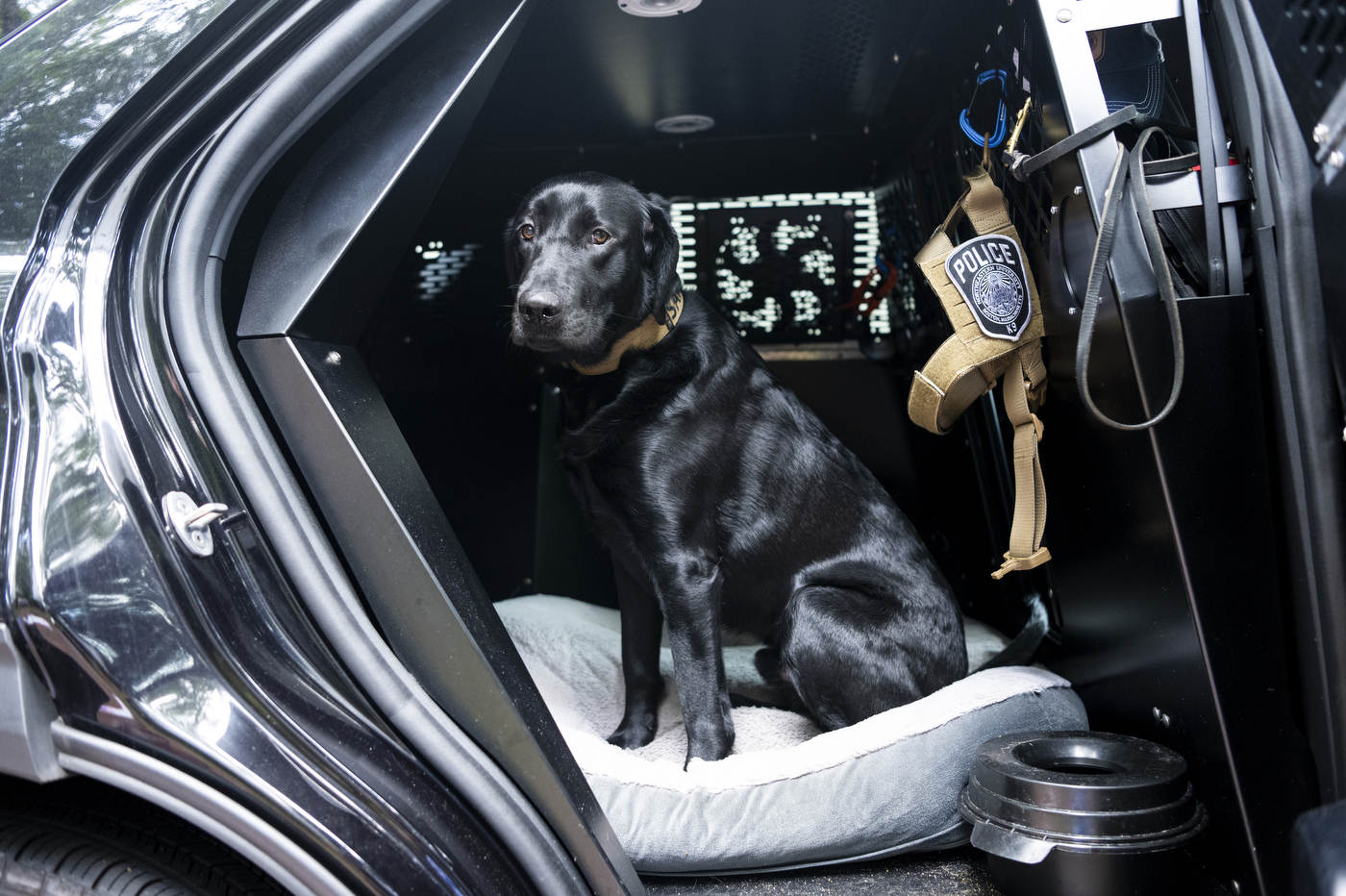
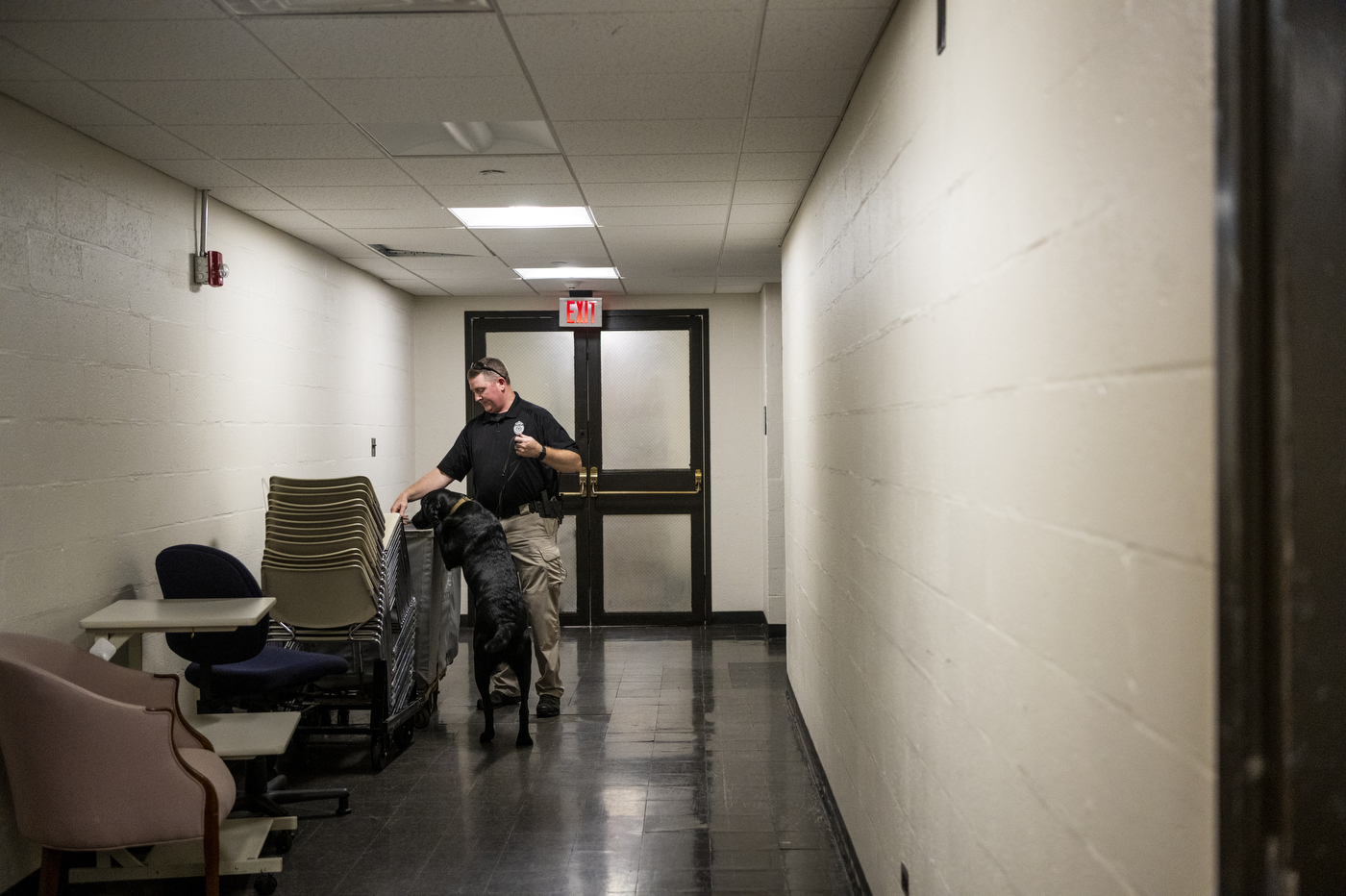
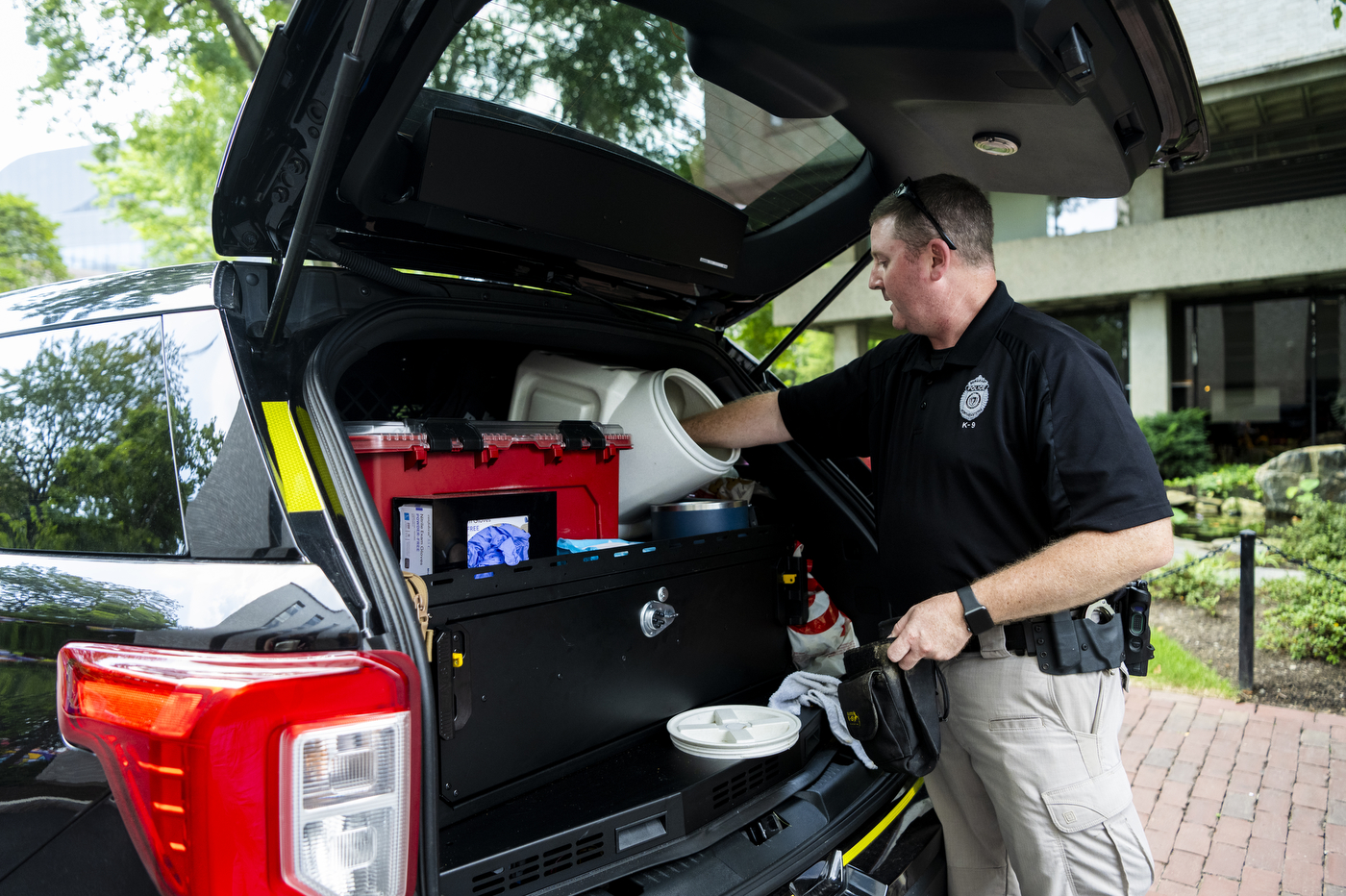
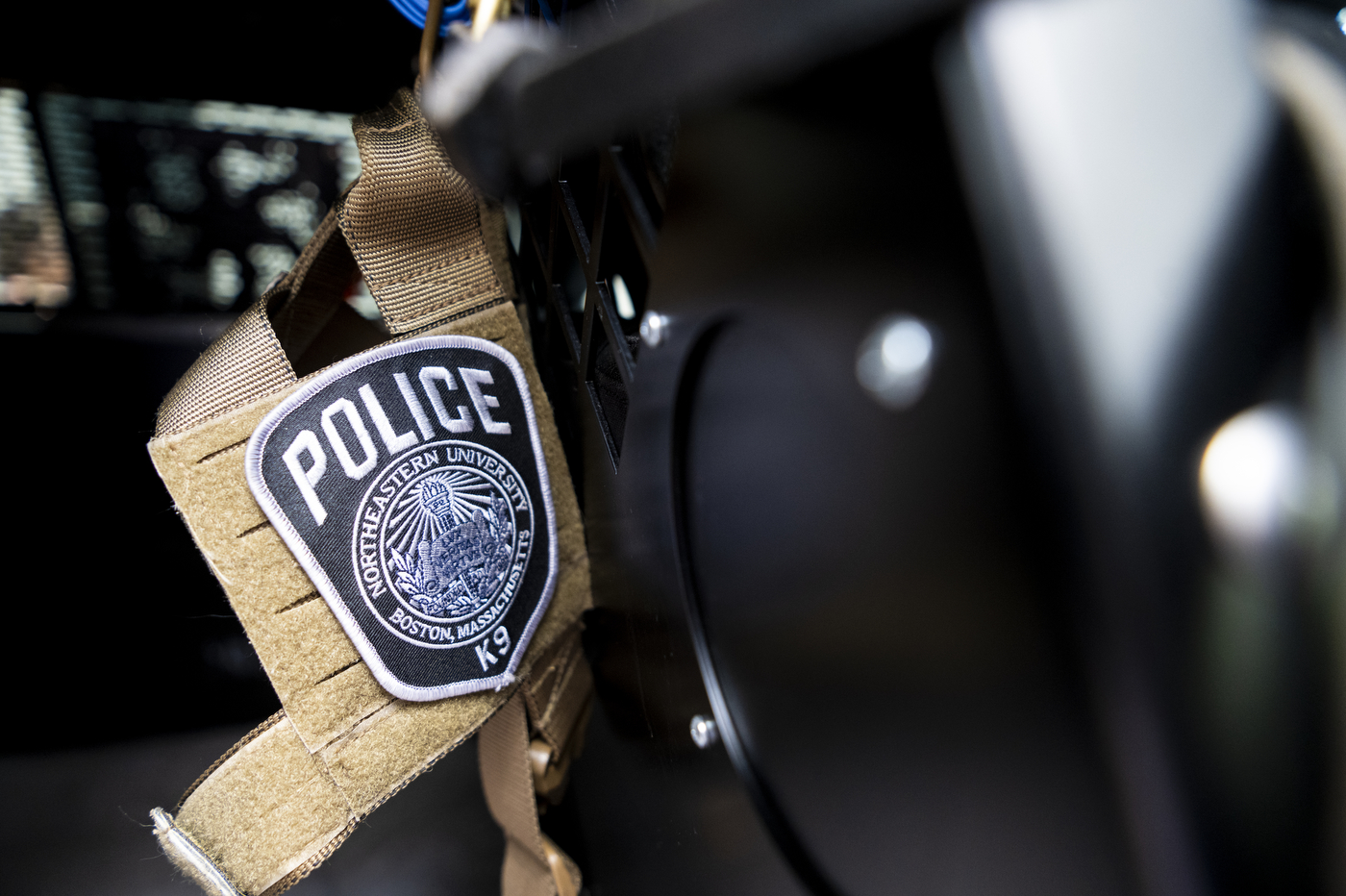
Back at Snell Quad, Sarge is ready for a short break. Corbett takes him for a rest in their K-9 squad car, a custom, climate-controlled black SUV with the back seats pulled out and a dog bed inside. He blasts the AC and gets ready for Sarge’s lunch, which doubles as a detection training session. While Sarge rests in the car, Corbett hides small, scented packets in a fire hydrant box, under a heating panel and in a half-dozen other corners of a quiet stairwell for Sarge to find. “I use a different location every time, and I try to switch up the time of day,” so he doesn’t get used to the routine, Corbett says.
Out of the car, rested and hungry, Sarge rushes around the space while Corbett jogs to keep the slack in his leash. When the dog stops and sits — the signal he’s found something — Corbett rewards him with an enthusiastic “Good boy!” and a piece of kibble.
It’s a brief interlude in his day. By mid-afternoon, he’s on Centennial Common, where throngs of students crowd around tables for all the clubs and extracurricular groups on campus and a concert stage is being readied for a performance that evening. Corbett says Sarge thrives in these big crowds; his first day on campus, they ran into a giant summer camp group, a potentially overwhelming encounter for a puppy that had spent most of his life to that point with a handful of people. “I didn’t know how he’d do with a group of little kids, but it was so much fun,” Corbett remembers. “All he did was jump up a little, but he got it.”
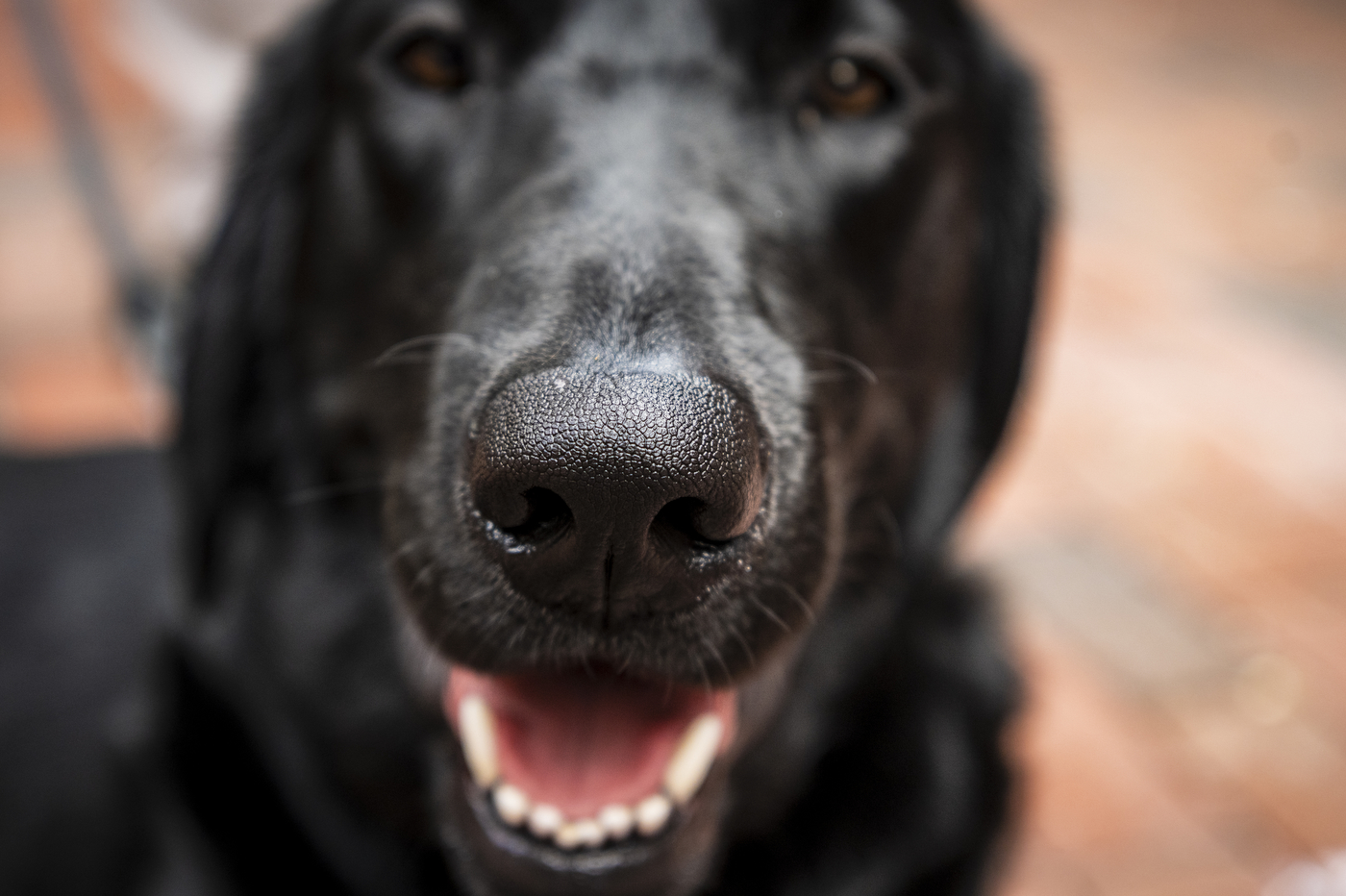
Children are his favorites, even in the Corbett household; most nights, after napping on the commute home, Sarge turns in around 8 p.m. and falls asleep in the bed with Corbett’s 11-year-old middle daughter. He’ll wake up at 5 a.m. tomorrow for another busy day, on hand for the first day of classes and a visit to the opening of the new EXP building.
Before that, there are a few temptations to avoid in the afternoon bustle on the common. Sarge leaves the squirrels alone and doesn’t even look twice at a box of sub sandwiches sitting ripe for the taking on the grass. But he can’t resist licking a piece of gum off the ground.
Schuyler Velasco is a Northeastern Global News Magazine senior writer. Email her at s.velasco@northeastern.edu. Follow her on Twitter @Schuyler_V.





